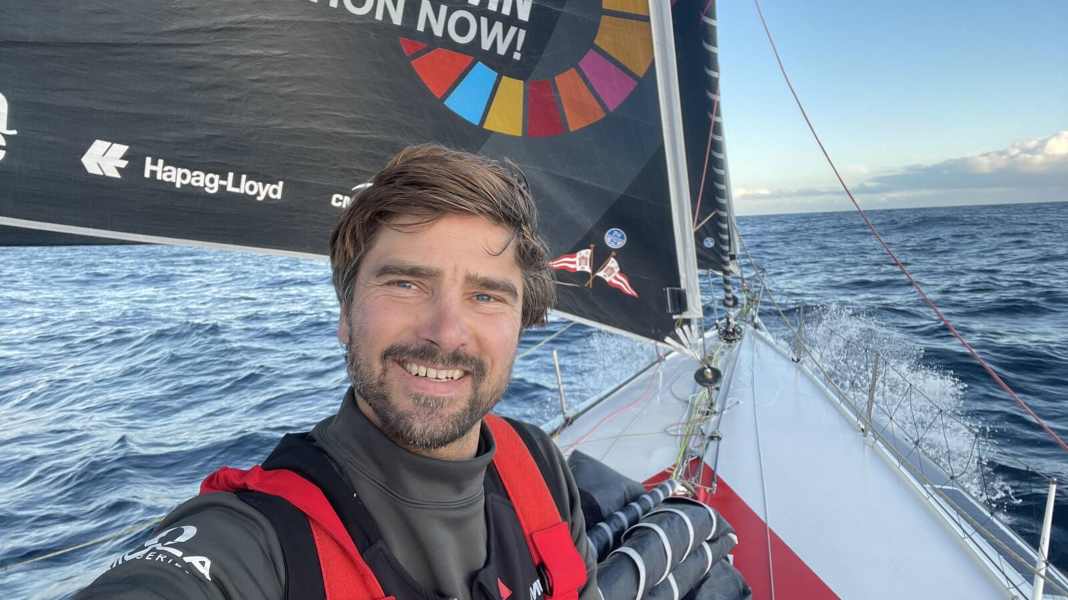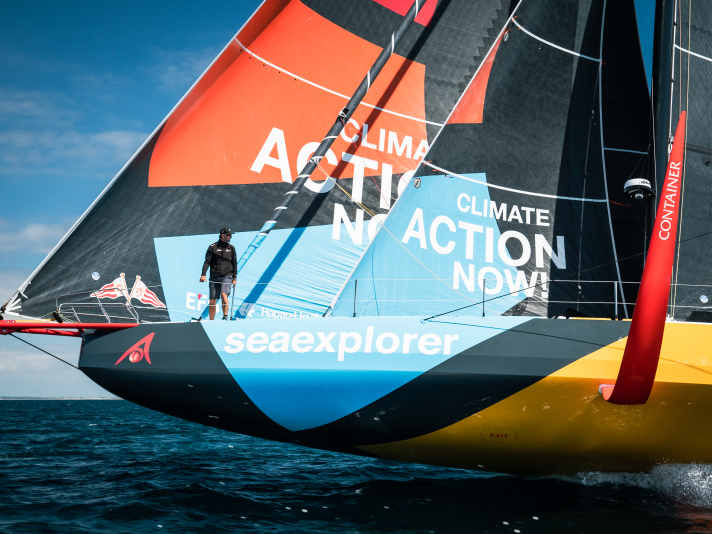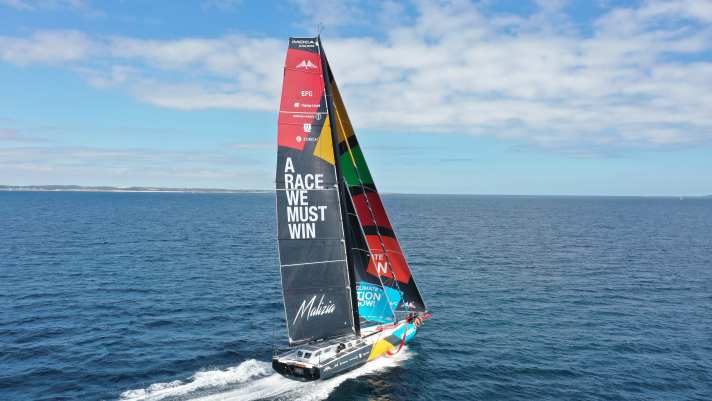Interview Boris Herrmann: "We had a grin on our faces during the tests downwind"
Andreas Fritsch
· 31.08.2022

The first two weeks of testing with the new boat are over. What are your impressions so far?
The French say "it was born well", which means that so far it has been a boat without any unexpected teething troubles or problems. There are boats that have a lot of problems in the shipyard or in the first week or even years. "Corum", for example, had a lot of bad luck, first it was finished far too late, then corona intervened and now they've lost a keel. They have never been able to finish a race. That makes you a bit superstitious, which is why we are so happy that everything is going so well for us.
Have you been able to sail in swell to see if the radical concept with the hull with a lot of rocker works well?
We simply had too little downwind with more wind, there was almost no wind the last few weeks. We had 20 knots once, but not long enough. There was a bit of swell and swell, but nothing earth-shattering. Nevertheless, we can imagine the boat quite well, it seems to work.

What are the next important steps or milestones you want to take?
It's about understanding how best to use the boat, when do I set which sail? Sometimes it's obvious, in light winds from astern I set the spinnaker, which of course doesn't surprise anyone. But what about at 18 knots from 90 degrees? Which sail combination is the most effective then? We have to test this systematically, for all sails, for all wind forces, because it's not so trivial. It may be that you get into foiling faster with a larger sail, but when you are foiling, it may be that you have more frictional resistance in the air with the large cloth at the top and the boat then no longer accelerates. In this case, you may prefer to set a smaller sail, which requires more effort to get the boat foiling and build up apparent wind. But once this has been achieved, the boat is more stable, better and even faster because the smaller sail has less wind resistance. The combination is also important: would you prefer a large headsail with a reef in the main or a smaller one?
Another point is the ballast. We have tanks at the back, front and sides. We also experiment a lot here. We've already had some surprising results. Some combinations that we thought would make us faster have actually made us slower. Others have been successful again and have stabilised the ship superbly.
What are your experiences with the new foils?
We have already learnt that a full foil is not always the best solution. You can also pull it in a little to stabilise the flight or, for example, to have less resistance in the water in lighter winds. There's a lot to learn, and it will probably take until the end of the Ocean Race. At least. I reckon we'll spend two years experimenting and finding out more and more.
Do you also do this more or less according to gut feeling and speed, or do the many measuring sensors play an important role?
We're not turning it into rocket science. We're looking to see whether it can be done faster this way or that. Of course, we keep an eye on the loads, but fortunately we haven't reached the limits yet. It looks quite good, the new foils seem to be much stiffer than those of the old boat, the load limits are higher. The alarms are simply triggered later than on the previous "Seaexplorer". It will only become more academic later on, when we reach the load limits and it's a question of how we can perhaps shift them a little by using less foil rake, less ballast or something like that. But at the moment it's still very pragmatic trial and error.
What are the most exciting results of the tests so far?
We have a very good feeling upwind, especially VMG downwind, where the boat performs really well. We had a two and a half day trip last weekend and came back with a nice high swell and 12 to 14 knots of wind. Malizia - Seaexplorer" was constantly foiling over 20 knots and up to 24 knots. And the autopilot kept the boat nice and straight on the foils, steering it aggressively. The boat remained very stable and constantly in its ideal "flying position". And the autopilot reacted very well to a change in the wave, especially when it came from behind. We all had a grin on our faces! That's what we wanted to achieve. Statistically, 65 to 70 per cent of the Vendée is sailed downwind, so we optimised the boat for that, and we seem to have succeeded. That's a bit of a difference to the Verdier boats, which all have some problems downwind but sail very well. We have set other priorities. Now we still have to learn all the other wind angles.

Are all the crew members for the Ocean Race on board all the time now, are you already sailing as a crew? Or are you already sailing single-handed for the Route du Rhum?
They are all already on board. It doesn't matter whether we're optimising the boat for the Ocean Race or the Vendée. We simply still have a lot to do, which is why we mostly sail at night so that the shore crew can work on the boat during the day. But this test phase will slowly come to an end at the end of August. Then comes the first training session in Port La Forêt and the confrontation with the other teams. Competing with the others for the first time will of course be an exciting moment.
Do you already know who you'll be meeting?
"Apivia" and "Linked Out" are the two strongest teams that will be there. They will probably be doing single-handed training for the Route du Rhum. We will be sailing as a crew, our focus is just a little different. We won't be sailing the Route du Rhum to win. It's more important that I qualify for the Vendée Globe and keep the boat in one piece so that we're ready for the Ocean Race.
Are there any real construction sites on board when you're sailing at night so that the team can work during the day?
A few things aren't finished yet, but that doesn't stop us from sailing. A seat is still being fitted, a hatch sealed here, cables pulled there, there's simply still a lot to do. But because we sail in shifts, we work on the boat 24 hours a day.
How many miles has "Malizia - Seaexplorer" already travelled in this way?
I don't know exactly, but I estimate around 2,000 miles. I once sailed 300 miles on my own as part of the qualifying for the Route du Rhum.
Do you have specific routes in mind?
No, you simply sail away from Lorient at a favourable wind angle and back again. Nothing spectacular.
How important is the christening in Hamburg for you?
I'm really looking forward to it. After all, our approach is to share the project with the people who support us, who cheer on the races with us. I'm looking forward to sailing up the Elbe and showing them the boat. And it's also a nice break for the team. After all the work, it's a welcome distraction.
What happens after your baptism?
After the azimuth race, it's Port la Forêt's turn. The boat is then taken back to the boatyard for a final check-up before the Route du Rhum. Now it's all about sailing. Now it's just a case of sailing, sailing, sailing, so that at some point we get to the point where we know the boat so well that we can feel at any moment that it wants a little more foil or a little less, different ballast distribution and so on. This takes much longer than with normal boats because the combination of ballast, foil and sails allows for so many variations. One year is really not much.
Around you, the other new buildings are being launched bit by bit, most recently "Charal" with the spectacular X-rudders. How do you see the competition developing?
Of course, everyone looks at what the others are doing. It's difficult to say what works and what doesn't, it's not easy to draw conclusions. You can only really say what works and what doesn't next year.
Is "Charal" the most extreme boat yet?
The rudders are extreme, the hull is very narrow and flat underwater. Three extreme decisions have been made. But the boat looks good, and from what you hear on the jetty, it also seems to run well.
Do you already know which direction the new "Apivia" and "Linked Out" by Charlie Dalin and Thomas Ruyant are heading in? They are likely to be two other big rivals at the Vendée.
"Linked Out" will probably be extreme, looks very narrow, it's hard to say about the others. But I think there will be some surprising new shapes. It never gets boring at the IMOCAs!

